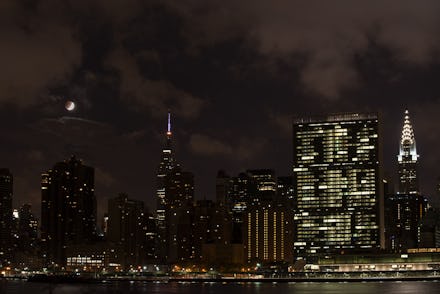Total Solar Eclipse 2017: How to get the best view if you’re not in the path of totality

On Aug. 21, swaths of the United States will be enveloped in a stunning midday darkness when the moon moves in front of the sun during the Great American Solar Eclipse. If you’re lucky enough to live along the path of totality, you’ll have a front seat to the greatest show on Earth — a rare event many say is life-changing.
The hubbub around the celestial occasion is already overwhelming, with chatter about traffic jams and bad visibility. But if you live anywhere in the U.S., you’ll be able to see a partial eclipse, which means you’re in for some breathtaking sights as the moon partially obscures the sun.
“[The view no matter where you are] is still pretty good,” Jackie Faherty, an astronomer at the American Museum of Natural History, said in an interview. “Depending on where you are exactly, you’ll see a big chunk of the sun get taken away by our lovely moon.”
“When it happens, it will start to look like the Death Star is entering the sun.” — astronomer Jackie Faherty
NASA will have a live stream of the eclipse, but Faherty says people living in places that will get a partial eclipse should prioritize seeing it with their own eyes. In New York City, where the moon will obstruct 71% of the sun, people will still experience magic.
“When it happens, it will start to look like the Death Star is entering the sun,” Faherty said of New York City. “This dark thing passes right over the sun. You’ll get a sliver crescent of a sun remaining. Then the moon will pass and you’ll get your full sun back.”
If you’re staying put in a major city like Los Angeles or New York, Faherty has a few tips for getting the most out of the Great American Eclipse.
1. Check the weather and be ready to relocate.
Clouds are an eclipse chaser’s nemesis, since they’ll block the view of the moon passing in front of the sun. Faherty recommended that people keep a close eye on weather patterns and even drive to get themselves to clear skies.
“Bus yourself out of the city to where it’s less overcast,” she said, explaining that she’ll be along the path of totality in Wyoming and Nebraska and intends to hop in a rental car to make a fast getaway to the clearest skies possible.
According to Faherty, people gazing outside won’t be able to tell that the eclipse is about to happen. To find out when the moon will begin eclipsing the sun, head to NASA’s site and put a pin on the map for where you’ll be watching. A dialogue box will pop up that will tell you what time the partial eclipse starts in your area, what time maximum eclipse will happen, and when the final partial eclipse will be over. Vox created another easy-to-use tool to find out this information — simply input your zip code on this page for a visualization of the full (or partial) eclipse happening in your area.
2. Stand near water instead of tall buildings.
It might seem obvious, but you shouldn’t expect to get a good view of the sky if you’re on the street surrounded by skyscrapers. Whether buildings or clouds are obstructing your view, try to find a clear path or an elevated viewing area to observe what’s going to happen to the sun.
According to Faherty, interesting shadows and reflections are some of the coolest parts about observing a partial eclipse. “Standing water will reflect the sun,” she said, explaining that any mirror-like surface that reflects the sun will be especially thrilling.
3. Make a party out of the wait.
Sure, Aug. 21 might be a Monday, but that doesn’t mean you should pray for a good view from work. Faherty said that it takes a few hours for the moon to pass completely across the sun, and it’s fun to gather with like-minded eclipse chasers for the suspenseful hour before it reaches maximum eclipse — the period when the moon is blocking as much of the sun as possible given your geographical location.
“I was [at the Museum of Natural History] for the Transit of Venus, and it was awesome. There was such a great community feel,” Faherty noted.
What to expect in cities around the country
Wondering what kind of partial eclipse you’ll observe? The rate of obscuration will change the shape of the sun. “For a person that will see 60% of the sun eclipsed, a little more than half will disappear. [At] 90%, there will just be a crescent sun peaking through,” Faherty said.
Here’s the rate of obstruction — how much the moon will be blocking the sun — for most of the major cities in the U.S., according to NASA.
Cities with 0% to 60% obstruction:
Honolulu (27%)
San Diego (57%)
Cities with 61% to 70% obstruction:
San Antonio (61%)
Los Angeles (62%)
Phoenix (63%)
Boston (63%)
Houston (66%)
Cities with 71% to 80% obstruction:
New York (71%)
Las Vegas (71%)
New Orleans (75%)
Dallas (75%)
Philadelphia (75%)
San Francisco (75%)
Miami (78%)
Baltimore (79%)
Detroit (79%)
Cleveland (80%)
Cities with 81% to 90% obstruction:
Pittsburgh (81%)
Washington (81%)
Milwaukee (83%)
Minneapolis (83%)
Oklahoma City (84%)
Chicago (86%)
Cities with over 90% obstruction:
Cincinnati (91%)
Indianapolis (91%)
Seattle (91%)
Salt Lake City (91%)
Denver (92%)
Atlanta (97%)
St. Louis (100%)